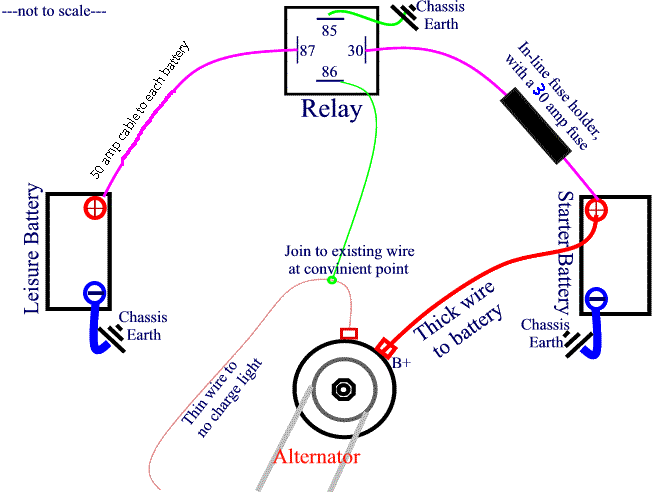Page 1 of 1
split charge
Posted: 10 Jul 2011, 18:06
by miggs
Hi All
Is it best to buy a split charge kit or build one up from scratch??
Re: split charge
Posted: 10 Jul 2011, 20:20
by colinthefox
Just use a relay. Wiring diagram in the Wiki
https://club8090.co.uk/wiki/Ca ... it_charger
Re: split charge
Posted: 10 Jul 2011, 20:34
by California Dreamin
Yup but don't follow that diagram as it's just wrong......
Someone modify the WIKI use this if you want, I've just put the one fuse in the circuit, it's up to you whether you fit two.
Relay should be at least 40amp rating.
30amp fuse (see how you go with this, if it blows regularly it might need upping to 40amps)
50amp (or higher) main battery to battery wiring
switch wire from the alternator would also benefit by being fused close to the alternator connection (not shown on the diagram but might be advisable to protect the wire from shorting, 7.5amp fuse should cover it with 16amp cable)

Martin
Re: split charge
Posted: 11 Jul 2011, 09:36
by 1664
The leisure battery end must be fused also
Re: split charge
Posted: 11 Jul 2011, 17:44
by Hacksawbob
Thanks updated that diagram, what guage of wire do you get for the main battery runs bearing in mind the length?
Re: split charge
Posted: 11 Jul 2011, 19:51
by California Dreamin
I put 50 amp cable down on the diagram as the typical single leisure plus starter (110amp plus 62amp/hour batteries for a petrol) will initially draw high 30's quickly dropping to low twenties on a flattish leisure) Petrol setup under both seats is only a short battery to battery run.
With a diesel (starter battery in the rear) the 'connection' cable length is likely much longer so a heavier link cable might be advisable to compensate for voltage drop.....the limitting factor will likely be cable ends, eyelets, spade connectors and fuse holders (70 - 80 amp...) just bare in mind that there will be an initial surge 'spike' but the average charge through this cable will be much lower..10 - 25 amps after just 30 - 90 seconds.
Martin
Re: split charge
Posted: 12 Jul 2011, 22:06
by California Dreamin
OK....I've took onboard one or two recommendations and added them to this latest diagram, it's now usable......Hacksawbob, if you can update the WIKI again.....Cheers.

Martin
Re: split charge
Posted: 13 Jul 2011, 08:40
by 1664
There is absolutely no need for the relay trigger wire and fuse to be that large - relay coil only takes mA
Re: split charge
Posted: 13 Jul 2011, 14:45
by California Dreamin
There is always someone....you are right Bren but then 1 amp cable is very thin and over 15/20 feet (from the alternator to the relay) will have quite a volt drop....1mm2 is just the smallest cable I would route physically, it just happens to be overated for this circuit but I don't see that as an issue.
16.5amp thinwall cable is just 1mm2 would you really want to route a cable thinner than this the complete length of the van?
The 7.5amp fuse is just to protect the wire from a dead short and for reliability...as in; you don't want it to blow with load, it is just there to protect from electrical fire if it chaffes through somewhere.
And....I said at least a 40 amp relays so users might choose much bigger (100/110amp) these definately don't switch with milliamps.
I accept that this split charge diagram is not the definitive answer as everyone has an opinion but it shows a good working solution.
I'm sure if you spend sometime drawing diagrams and writing up solutions to this question it will be added to the WIKI as well to give another alternative.
Martin
Re: split charge
Posted: 13 Jul 2011, 16:13
by 1664
I agree with you,1.00mm cable is certainly the smallest physical size of cable I'd be willing to run too. However I didn't know you were proposing thin wall cable; other types would be larger for 16A. My bad

.
However, my statement regarding fuse size is certainly valid - yes the fuse is there to protect the cable but it should also be sized to protect the equipment connected to it if it has no fuse of it's own, which in this case is a relay coil that takes less than half an amp whatever it's switching capacity (0.36A or 360mA for my 100A split charge relay). In the unlikely event of a problem within the relay a 7.5A fuse will probably just sit there and watch it burn. I'd chuck an in-line slow blow 1A in that's plenty big enough.
Re: split charge
Posted: 13 Jul 2011, 21:38
by California Dreamin
I agree Bren but if I'm honest, when we used to fit split charge systems on VW's back when these vans were new, we never fitted a fuse and holder to the switch line anyway, we just spliced directly into the alternators exciter feed.
When I altered the original diagram (non fused switch feed) I thought it was a wise inclusion and I accept that the 7.5amp fuse could just as easily be replaced with something lower (2amps)
In terms of damaging the relay coils I say so be it! relays are cheap and I've never seen one catch fire, It's the wire itself I'm bothered about and it's potential, under dead short circumstance, to light up like a glow plug and cause an electrical fire buried under carpets etc. The lowly 7.5 amp fuse would stop this and that was my concern.
Martin

